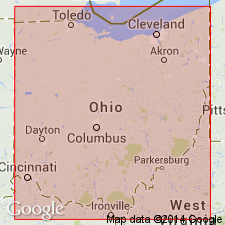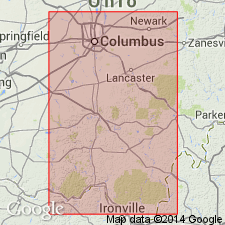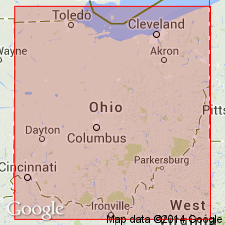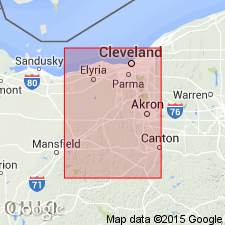
- Usage in publication:
-
- Black Hand conglomerate
- Modifications:
-
- Original reference
- Dominant lithology:
-
- Conglomerate
- AAPG geologic province:
-
- Appalachian basin
Summary:
Pg. 216, 217. Black Hand conglomerate. Generally rather fine "pudding" stone; in places beds many feet thick are merely coarse sandstone with pebbly partings; chiefly light yellow or buff color; in some places nearly white, or brick red; highly ferruginous, but less so than Coal Measures conglomerate; also contains more earthy matter and less pure silica than latter conglomerate. Thickness 85 to 90 feet. Overlain by Licking shales [Logan formation] and underlain by Raccoon [Cuyahoga] shales. All included in Waverly group. Age is Mississippian.
Named from exposures at Black Hand, Licking Co., central OH.
[See also under Black Hand member.]
Source: US geologic names lexicon (USGS Bull. 896, p. 201).

- Usage in publication:
-
- Black Hand member
- Modifications:
-
- Revised
- Dominant lithology:
-
- Sandstone
- AAPG geologic province:
-
- Appalachian basin
Summary:
Pg. 657, 667-682, 757-779. Black Hand member of Cuyahoga formation. Massive coarse quartz sandstones with occasional shaly beds; usually yellow or buff, sometimes reddish. Thickness 50 to 150 feet. Is a local development of Cuyahoga formation [expanded definition] and not as important a stratigraphic unit as any one of the three members of the Logan. Underlies Berne member. In central Ohio overlies Raccoon member of Cuyahoga, In Hocking Valley overlies Fairfield member of Cuyahoga formation. Age is Mississippian.
[GNC remark (ca. 1938, US geologic names lexicon, USGS Bull. 896, p. 201): Appears to be basal part of Black Hand formation of Prosser and other geologists.]
[GNU remark (May 11, 1993, USGS DDS-6; Reston GNULEX): Revised the Black Hand to the Black Hand member of the Cuyahoga formation and redescribed it to include only the basal sandstone of the Black Hand conglomerate described by Hicks (1878).]
Source: US geologic names lexicon (USGS Bull. 896, p. 201); supplemental information from GNU records (USGS DDS-6; Reston GNULEX).

- Usage in publication:
-
- Black Hand member
- Modifications:
-
- Overview
- AAPG geologic province:
-
- Appalachian basin
Summary:
According to Jesse E. Hyde (Jour. Geol., v. 23, p. 659, 1915) and C.S. Prosser (Ohio Geol. Survey, 4th ser., Bull., no. 7, p. 17, 1905) there is difference of opinion regarding the rocks originally included in Logan sandstone by E.B. Andrews, also regarding the correct definitions of Black Hand and Cuyahoga. In paper cited Hyde included part of the Black Hand in Logan formation and the rest of it in Cuyahoga formation, and restricted the name Black Hand to a member of latter formation, as expanded by Hyde. This member was described as consisting of 50 to 150 feet of coarse pebbly sandstone with occassional beds of conglomerate lying between Berne member above and Fairfield member below, or to beds older than congloemrate 1 of Prosser. This classification was also followed by W. Stout, 1927 (Ohio Geol. Survey, 4th ser., Bull., no. 31, p. 47), and appears to be present definition of Ohio Geol. Survey. According to Hyde (1915) the Black Hand formation of Prosser extended from top of Hyde's Allensville member to base of his Black Hand member. Age is Mississippian.
Source: US geologic names lexicon (USGS Bull. 896, p. 201).

- Usage in publication:
-
- Black Hand shale member
- Black Hand conglomerate member
- Modifications:
-
- Revised
- AAPG geologic province:
-
- Appalachian basin
Summary:
Pg. 172; Jour. Geol., v. 50, no. 1, p. 49-50. Seven lithologic facies, each subdivided into a varying number of members and submembers are recognized in Cuyahoga formation. Black Hand shale is member of Killbuck shale facies (new); Black Hand conglomerate is member of River Styx (new), Toboso, and Hocking Valley conglomerate facies. Overlies Armstrong sandstone member. Thickness 75 to 80 feet. Age is Mississippian.
Source: US geologic names lexicon (USGS Bull. 1200, p. 363-364).

- Usage in publication:
-
- Black Hand member
- Modifications:
-
- Revised
- AAPG geologic province:
-
- Appalachian basin
Summary:
Black Hand member of Cuyahoga formation. Cross-bedded pebbly sandstone. Uppermost member of Cuyahoga. In Cuyahoga, Summit, Medina, and Lorain Counties, term Wooster shale member (new) is used in place of Black Hand, because term Black Hand is restricted to the pebbly sandstone. Intertongues with Wooster shale and, in parts of Wayne, Medina, and Ashland Counties, the sandstone is completely replaced by shale. Age is Mississippian.
Source: US geologic names lexicon (USGS Bull. 1200, p. 363-364).
For more information, please contact Nancy Stamm, Geologic Names Committee Secretary.
Asterisk (*) indicates published by U.S. Geological Survey authors.
"No current usage" (†) implies that a name has been abandoned or has fallen into disuse. Former usage and, if known, replacement name given in parentheses ( ).
Slash (/) indicates name conflicts with nomenclatural guidelines (CSN, 1933; ACSN, 1961, 1970; NACSN, 1983, 2005, 2021). May be explained within brackets ([ ]).

